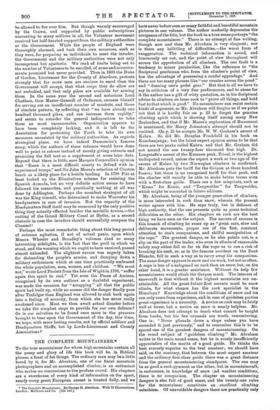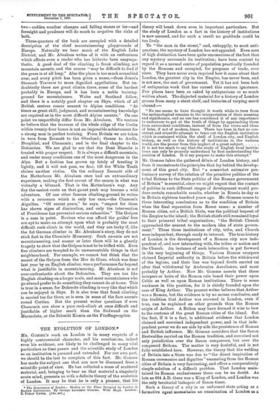THE COMPLETE MOUNTAINEER.* To the true mountaineer for whom high
mountains contain all the pomp and glory of life this book will be, in Biblical phrase, a feast of fat things. The ordinary man may be a little bored by it, for Mr. Abraham, one of our finest mountain photographers and an accomplished climber, is an enthusiast who makes no concessions to the profane crowd. His chapters are a storehouse of every kind of information on the sport, nearly every great European ascent is treated fully, and we
• The Complete Mountaineer. By George D. Abraham. With 75 Illustrations. London : Methuen and Co. [15s. net.]
have never before seen so many faithful and beautiful mountain pictures in one volume. The author modestly deprecates the • arrogance of the title, but the book in a true sense portrays " the complete mountaineer." There is no attempt at fine writing, though now and then Mr. Abraham is very eloquent; nor is there any belittling of difficulties,—the worst form of • exaggeration. The technical information is sound, and luminously set out, and the point of view throughout will secure the approbation of all climbers. The one fault is a tendency to minor jocularities, like the reference to "the Scriptural gentleman who, from the climber's point of view, has the advantage of possessing a caudal appendage." And there are too many phrases like " our cousins across the pond " and " donning one's pedal gear." But that is all we have to say in criticism of a very fine performance, and to atone for it the author has a gift of witty quotation, as in his Scriptural advice to climbers on loose rock to " prove all things, and hold fast to that which is good." No mountaineer can resist certain kinds of argument, so Mr. Abraham will forgive us if we point out that it is hardly fair on p. 23 to forget the genuine climbing spirit which is showing itself among many New Zealanders, and that if Mr. Moore's exploration of Ruwenzori is mentioned, Sir Harry Johnston's attempt should not be omitted. On p. 25 he accepts Mr. W. W. Graham's ascent of Kabru. So did Mr. Douglas Freshfield in his book on Kanchanjanga ; but the latest expert opinion seems to be that there are two peaks called Kabru, and that Mr. Graham did not ascend the one twenty-four thousand feet high. Dr. Longstaffe's ascent of the Kumaon peak, Trisul, is the highest undisputed record, unless the report a week or two ago of the ascent of Kabru by two Norwegian climbers is confirmed. Mr. Abraham puts the tariff for the Grepon at three hundred francs; but there is no recognised tariff for that peak, and the climber will usually be able to make better terms even with a first-class guide. There are a few misprints, such as " Kema" for Kenia, and " Tangwalder " for Taugwalder, which might be corrected in future editions.
Mr. Abraham, being of the younger generation of climbers, is more interested in rock than snow, wherein the present writer agrees with him. He says truly, but in defiance of high authority, that the one presents quite as great technical difficulties as the other. His chapters on rock are the best thing we have seen on the subject. The secrets of success in this branch of climbing ho sums up as "great care, slow and . deliberate movements, proper use of the feet, constant attention to one's companions, and skilful manipulation of the rope." The greatest danger, as he also points out, is a slip on the part of the leader, who even in climbs of reasonable safety may either fall so far on the rope as to run a risk of breaking his neck, or, as in the famous accident on the Dent Blanche, fall in such a way as to carry away his companions. The same danger appears in snow and ice work, but not so often. A rope is less of a safeguard on rock than on snow, but, on the other hand, it is a greater assistance. Without its help few mountaineers would climb the Grepon crack. The interest of snowcraft is that without it the highest mountains are un- attainable. All the great future first ascents must be snow climbs, for what chance has the rock specialist in the Himalaya? Knowledge about the conditions of snow and ice can only come from experience, and in case of guideless parties great experience is a necessity. A novice on rock may be fairly well at home, but a novice on snow is nearly helpless. Mr. Abraham does not attempt to teach what cannot be taught from books, but his few counsels are worth remembering. One is : " Never glissade down a slope unless you have ascended it just previously," and to remember this is to be spared one of the greatest dangers of mountaineering. On the vexed subject of " guideless climbing " Mr. Abraham writes in the main sound sense, but he is surely insufficiently appreciative of the merits of a good guide. He thinks the best scarcely superior to the best amateur; we should have said, on the contrary, that between the most expert amateur and the ordinary first-class guide there was a great distance. from the general mountaineering standpoint. The one may be as good a rook-gymnast as the other, but in mountaincraft, in endurance, in knowledge of snow raid weather conditions, there is no comparison. The chapter on mountaineering dangers is also full of good sense, and the twenty-one rules for the mountaineer constitute. an . excellent climbing catechism. Of unavoidable dangers there are practically only
two—sudden weather changes and falling stones or ice—and foresight and prudence will do much to negative the risks of both.
Three-quarters of the book are occupied with a detailed description of the chief mountaineering playgrounds of Europe. Naturally we hear much of the English Lake District, and Mr. Abraham writes of it with an enthusiasm which affects even a reader who has hitherto been unsympa- thetic. A good, deal of the climbing is freak climbing, not mountain ascents, and the course " may be difficult to find if the grass is at all long." Also the place is too much scrambled over, and every pitch has been given a name,—from Jones's Stomach Traverse to more dignified appellations. But un- doubtedly there are great climbs there, some of the hardest probably in Europe, and it has been a noble training- ground for mountaineers. Wales and Scotland follow, and there is a notably good chapter on Skye, which of all British centres comes nearest to Alpine conditions. "At times as great skill, judgment, and mountaineering knowledge are required as in the most difficult Alpine ascents." On one point we respectfully differ from Mr. Abraham. We venture to believe that the traverse of the whole ridge of the Coolin within twenty-four hours is not an impossible achievement for a strong man in perfect training. From Britain we are taken in turn from Zermatt to the Oberland ; thence to Arolla, Dauphine, and Chamonix ; and in the final chapter to the Dolomites. We are glad to see that the Dent Blanche is treated with proper respect. It is always a difficult mountain, and under many conditions one of the most dangerous in the Alps. But a fashion has grown up lately of treating it lightly, and it will not pass, we fear, till the White Tooth claims another victim. On the ordinary Zermatt side of the Matterhorn Mr. Abraham once had an extraordinary experience, making the first ascent of the season in what was virtually a blizzard. That is the Matterhorn's way. Any day the easiest route on that gaunt peak may become a wild adventure. Of one other famous climbing-ground he writes with a reverence which is only too rare,—the Chamonix Aiguilles. "Of recent years," he says, "respect for them has shown signs of diminution, and only the intervention of Providence has prevented serious calamities." The Grepon is a case in point. Novices who can afford the guides' fees are apt to make an attempt upon what is probably the most difficult rock-climb in the world, and they are lucky if, like the .fat German climber in Mr. Abraham's story, they do not stick fast in the Cheminee Mummery. Such ascents are not mountaineering, and sooner or later there will be a ghastly tragedy to show that the Grepon is not to be trifled with. Even fine climbers are tempted to do unwarrantable things in that neighbourhood. For example, we cannot but think that the ascent of the Grepon from the Mer de Glace, which was done last year by an English climber, was a performance far beyond what is justifiable in mountaineering. Mr. Abraham is not over-enthusiastic about the Dolomites. They are too like English climbing on a larger scale, and most mountaineers who go abroad prefer to do something they cannot do at home. This is true in a sense, for Dolomite climbing is very like that which can be enjoyed in Skye. It is also true that freak climbing is carried too far there, as is seen in some of the face ascents round Cortina. But the present writer questions if even Chamonix can show a pure rock-climb at once difficult and justifiable of higher merit than the Siidwand on the Marmolata, or the Schmitt Kamin on the Fiinffingerspitze.











































































 Previous page
Previous page